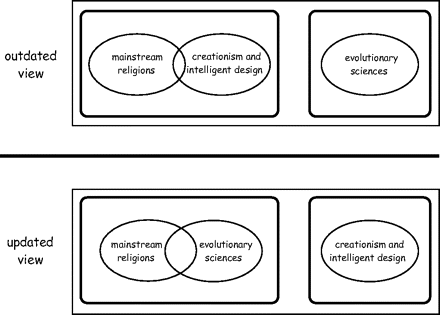The argument that an intelligent agent, God, created organisms as opposed to the idea of natural selection as an evolutionary mechanism has been questioned. John C. Avise, in his 2010 publication in the Proceedings of National Academy of Science of the United States of America, discusses various genome level dysfunctions that question intelligent design and approve evolution and natural selection.
Avise (1) argues that mainstream religions and evolutionary sciences should seek to share their philosophical views and move away from the views of intelligent design and aspects of creationism. This, according to Avise (1), will change the older views of distancing evolutionary sciences and the minimal interaction between mainstream religions’ philosophy and the views of creationism.

Numerous examples of genome-level dysfunctions that have been discovered since the elucidation of the human genome have been provided by the author as an illustration that intelligent design no longer holds water. The discovery of metabolic errors in the early 1900s as a cause of diseases like albinism indicates the flaws in the human genome that defy intelligent design by a caring agent. Harmful mutations have been elucidated as causes of at least 500 genetic disorders. Mutations that have been described occur in virtually every part of the body and up to 75% of these lead to death before the individual celebrates the 30th birthday.
Avise (1) states that the ubiquity of molecular dysfunctions disapproves that intelligent design is evident through the biological complexity of organisms. For instance, splicing-which leads to the generation of functional proteins- is not just advantageous but also leads to abnormal proteins if splicing is not accurate. The author indicates that up to a third of all genetic disorders in humans result from mistakes during protein processing. Lou Gehrig disease and various cancers are examples of blunders in protein synthesis.
Further evidence that creationism is outdated and that evolutionary sciences ought to form part of mainstream religions instead of distancing it is shown by the genome’s great potential to self-repair and perform DNA modifications. Self-surveillance of the genome is exhibited by the presence of sequences that can activate gene production-enhancers or reduce gene production silencers. Regulatory signals in the human genome help in destroying faulty genes and avoiding flaws in proteins. Malfunctions in gene regulation lead to disease conditions such as cancers. Such arguments make Avise (1) question the intelligent designer as imperfect and even points out that perhaps the correctional mechanism in DNA was an action by the designer after discovering his imperfection. The author explains that evolutionary forces such as mutation and natural selection provide a better explanation for those genomic flaws.
Mitochondria DNA (mtDNA) are another piece of evidence that disapproves the argument of intelligence design. MtDNA contains many mutations which can lead to a lot of health problems if its function of aiding energy production in the mitochondria is interfered with. Moreover, the mtDNA is very different from the other genome in the nucleus and it cannot perform gene regulation. This makes the author argue that “not only is the overall design of the mtDNA suboptimal, but it appears downright ludicrous!” (1, p. 9874). The existence of duplicate genes renders organisms to have abnormalities, some of which are genetically inherited while others occur spontaneously. The human genome also contains mobile elements whose random insertion into a genome can lead to human disease, gamete death as well as compromised fertility.
The observed genomic mistakes cast serious doubt on the intelligence design theory as they are against the principle of the caring agent. It is for these reasons that Avise calls for reconciliation between evolutionary biology and mainstream religions’ philosophies.
Reference List
Avise JC (2010) Footprints of nonsentient design inside the human genome. Proceedings of the National Academy of Sciences, USA, 107, 8969-8976.